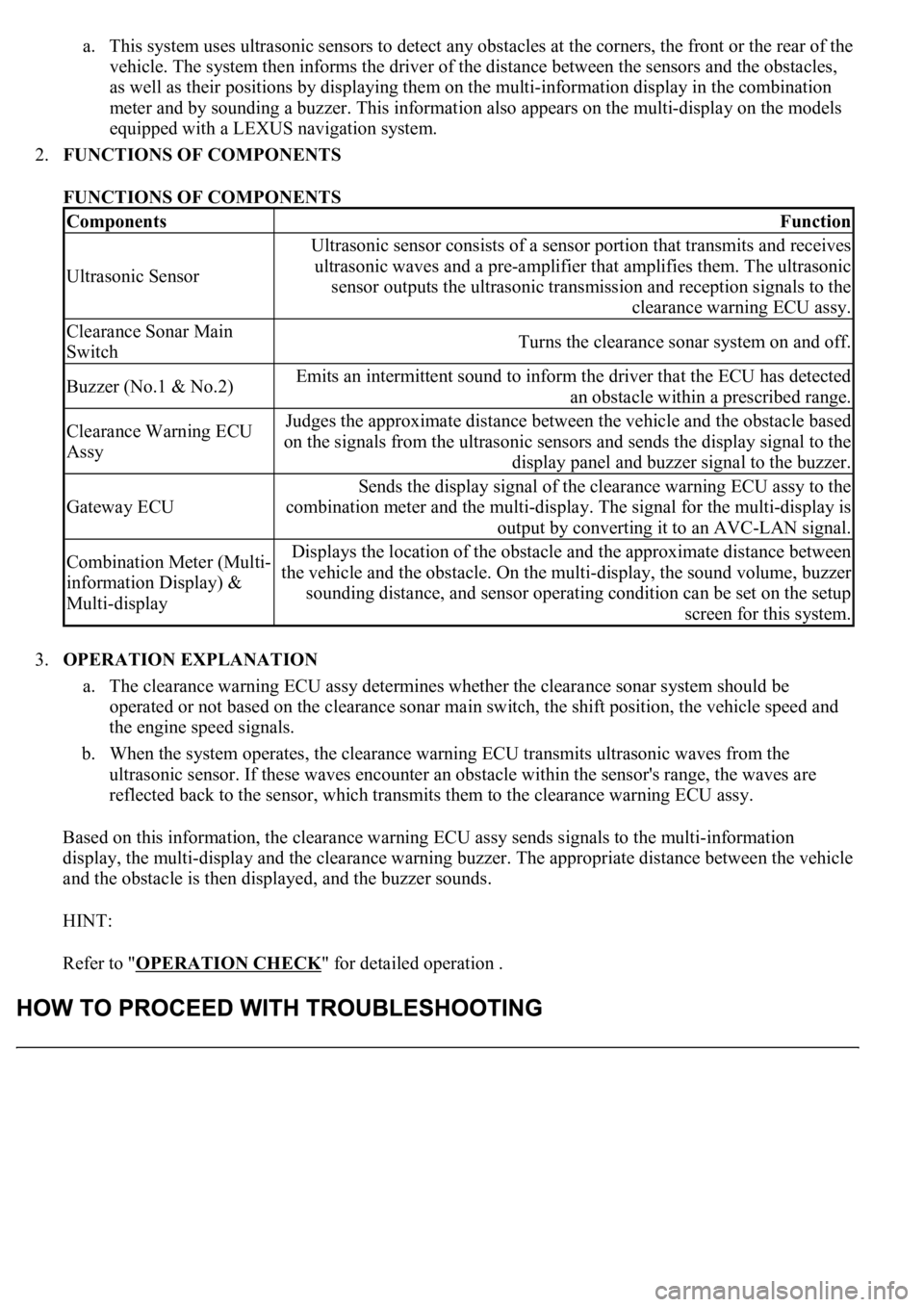Page 1493 of 4500
Fig. 278: Identifying DLC3 Connector terminals
Courtesy of TOYOTA MOTOR SALES, U.S.A., INC.
b. Measure the resistance according to the value (s) in the table below.
Standard:
DLC3 CONNECTOR TERMINALS RESISTANCE
OK: Go to step 30
NG: GO TO NEXT STEP
28.CONNECT CONNECTOR
a. Reconnect the distance control ECU sub bus line connector (J48) to the P-CAN J/C B side (w/o
earth terminal).
29.CHECK CAN BUS LINE FOR SHORT TO GND (YAW RATE SENSOR SUB BUS LINE)
Tester connectionConditionSpecified value
D1-6 (CANH) - D1-14 (CANL)Ignition Switch OFF54 to 69 ohms
Page 1494 of 4500
Fig. 279: Disconnecting Yaw Rate Sensor Sub Bus Line Connector (J44) From P-CAN J/C A Side
(W/Earth Terminal)
Courtesy of TOYOTA MOTOR SALES, U.S.A., INC.
a. Disconnect the yaw rate sensor sub bus line connector (J44) from the P-CAN J/C A side (w/earth
terminal).
Page 1497 of 4500
32.CONNECT CONNECTOR
a. Reconnect the yaw rate sensor sub bus line connector (J44) to the P-CAN J/C A side (w/earth
terminal).
33.CHECK CAN BUS LINE FOR SHORT TO GND (YAW RATE SENSOR SUB BUS LINE)
Fig. 282: Identifying DLC3 Connector terminals
Courtesy of TOYOTA MOTOR SALES, U.S.A., INC.
a. Disconnect the yaw rate sensor connector (Y1).
b. Measure the resistance according to the value (s) in the table below.
Standard:
DLC3 CONNECTOR TERMINALS RESISTANCE
OK: REPLACE YAW RATE SENSOR (SEE REPLACEMENT
)
Tester connectionConditionSpecified value
D1-6 (CANH) - D1-4 (CG)Ignition Switch OFF1 kohms or more
D1-14 (CANL) - D1-4 (CG)Ignition Switch OFF1 kohms or more
Page 1498 of 4500
NG: REPAIR OR REPLACE YAW RATE SENSOR SUB BUS LINE OR CONNECTOR (CAN-H,
CAN-L)
Page 1503 of 4500

a. This system uses ultrasonic sensors to detect any obstacles at the corners, the front or the rear of the
vehicle. The system then informs the driver of the distance between the sensors and the obstacles,
as well as their positions by displaying them on the multi-information display in the combination
meter and by sounding a buzzer. This information also appears on the multi-display on the models
equipped with a LEXUS navigation system.
2.FUNCTIONS OF COMPONENTS
FUNCTIONS OF COMPONENTS
3.OPERATION EXPLANATION
a. The clearance warning ECU assy determines whether the clearance sonar system should be
operated or not based on the clearance sonar main switch, the shift position, the vehicle speed and
the engine speed signals.
b. When the system operates, the clearance warning ECU transmits ultrasonic waves from the
ultrasonic sensor. If these waves encounter an obstacle within the sensor's range, the waves are
reflected back to the sensor, which transmits them to the clearance warning ECU assy.
Based on this information, the clearance warning ECU assy sends signals to the multi-information
display, the multi-display and the clearance warning buzzer. The appropriate distance between the vehicle
and the obstacle is then displayed, and the buzzer sounds.
HINT:
Refer to "OPERATION CHECK
" for detailed operation .
ComponentsFunction
Ultrasonic Sensor
Ultrasonic sensor consists of a sensor portion that transmits and receives
ultrasonic waves and a pre-amplifier that amplifies them. The ultrasonic
sensor outputs the ultrasonic transmission and reception signals to the
clearance warning ECU assy.
Clearance Sonar Main
SwitchTurns the clearance sonar system on and off.
Buzzer (No.1 & No.2)Emits an intermittent sound to inform the driver that the ECU has detected
an obstacle within a prescribed range.
Clearance Warning ECU
AssyJudges the approximate distance between the vehicle and the obstacle based
on the signals from the ultrasonic sensors and sends the display signal to the
display panel and buzzer signal to the buzzer.
Gateway ECU
Sends the display signal of the clearance warning ECU assy to the
combination meter and the multi-display. The signal for the multi-display is
output by converting it to an AVC-LAN signal.
Combination Meter (Multi-
information Display) &
Multi-displayDisplays the location of the obstacle and the approximate distance between
the vehicle and the obstacle. On the multi-display, the sound volume, buzzer
sounding distance, and sensor operating condition can be set on the setup
screen for this system.
Page 1507 of 4500
a. Turn the ignition switch to the ON position.
b. Move the shift lever to the D position (when the front sonar and the front clearance sonar are
checked).
c. Move the shift lever to the R position (when the back sonar and the rear clearance sonar are
checked).
d. Turn the clearance sonar main switch on.
e. Move a diameter 60 mm (2.36 in.) pole around the sensor to measure the detection range of the
sensor.
Page 1508 of 4500
Fig. 5: Identifying Front And Back Sonar's Detection Ranges
Courtesy of TOYOTA MOTOR SALES, U.S.A., INC.
f. Check the multi-information display, the multi-display and the buzzer sounding condition when the
front sensor detects an obstacle.
Operation condition:
Page 1510 of 4500
Fig. 6: Identifying Front Sonar Display
Courtesy of TOYOTA MOTOR SALES, U.S.A., INC.
g. Check the multi-information display and the buzzer sounding condition when the back sensor
detects an obstacle.
Operation condition:
Back sonar:
CLEARANCE SONAR MAIN SWITCH